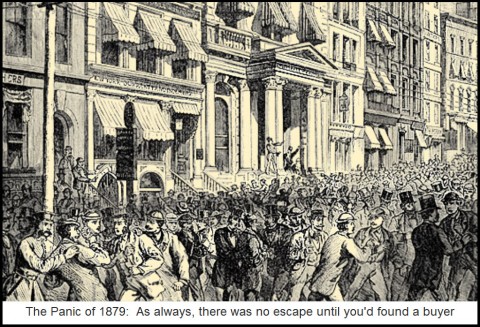[We wrote here recently that last week’s panic attack on Wall Street is unlikely to be the last. The markets have since rallied strongly, but that won’t change the outlook, says a wise friend of ours who has been following the markets for thirty years. In the essay below, he explains why shouting “Fire!” on Wall Street is not quite the same as shouting “Fire!” in a crowded theater. RA]
“Many years ago, while reading John Kenneth Galbraith in “The Speculative Episode,” it dawned on me that the world wasn’t necessarily becoming a safer place, particularly on Broad and Wall. If you think about military history, we’ve gone from flintlocks during the Revolutionary War with a range of 40 feet to the Spencer Repeating Carbine at Pickett’s Charge in the Civil War (every Confederate soldier died), to Hiroshima. On Wall Street, we went from the ticker tape running three hours late on 16 million shares in 1929 to program trading in 1987 when we didn’t have the Internet and you had to call your broker to know what was happening that day in the market.
“Today, everyone has a quote in the corner of their screen at work or they watch CNBC at home. They are responsible for allocating their 401K online and many trade the rest of their nest eggs there too. The data processing capabilities out there can handle tens of billions of sell orders in a single day and on top of that, we have the CBOE and the E-Mini. Algorithmic Trading programs do umpteen trades a millisecond and make up 70% of the volume, one HAL versus another.
Technology Produces No Buyers
“The biggest problem, getting back to Galbraith, is that in the process of facilitating sellers, all the new technology does not produce any buyers. I know most will disagree with that, but keep in mind that demand is a state of mind. It runs away at the first sign of trouble. Put another way, the same emotions that motivate sellers cause potential buyers to hold off. Sell is preordained, but buying requires a complex greed analysis. Which leads me to my “glass theater analogy.” We are all familiar with the most common analogy for panic: when someone yells “Fire!” in a crowded theater. The problem, of course, is that there are 50 rows of seats, but just two aisles leading back to two doors on the back wall. Grown men and women may trample small children to escape getting fried.
“There are a couple of problems extending that analogy to the stock market, so I made some changes in my “glass theater analogy”. The biggest problem in the market is that, even if you choose the aisle seat, last row, you can’t escape unless you can find someone to take your seat. As Galbraith pointed out so many years ago, you can’t be a seller unless someone else will buy. (What a dirty little secret!). Another big problem, considering the speed of the technology today, is the basic transparency. It’s as though the back wall of the theater were made of glass, and all the potential patrons can see what’s happening inside. It’s right there on their screen! Who is going to take your seat when they can see the carnage going on in there? Which leads me back to last week’s mysterious plunge. First of all, remember that reading Alan Abelson the Saturday before the 1987 Crash, he indicated we had already had it with the 230-point drop the week before. The newspapers last weekend sounded a bit like a post mortem too. “The SEC is trying to get to the bottom of it.” I can save them the trouble. What do you expect when your weapon has a seven cartridge magazine in the butt compared to a single load, wad and ball. You get 1000 points in 15 minutes. Wait until the human nature kicks in again someday, in a big way. It might become 5000 points. You could retrace this bear market rally in a hurry.
(If you’d like to have Rick’s Picks commentary delivered free each day to your e-mail box, click here.)


Very unusual to have a market where the sellers had been taking a haircut for so long with a perpetual state of low volume buying, then suddenly turn them all into sellers in one go in one huge short sale.
A successful short sale of this magnitude would have netted untold billions and shaken market confidence, but the rebound was so sharp, the end result would have been missed. A sell off was due, so taking advantage of hft in this fashion is not always a sure gamble.
What’s even more unusual is the dip in the discount rate some 30% that day and its subsequent rebound the next of 20%. Rates are so low now that they’ll hit zero or go negative in very short order. A negative interest rate can have an adverse effect on valuations of just about everything.
http://stockcharts.com/h-sc/ui?s=$IRX&p=W&b=5&g=0&id=p66874059515&a=191210523&listNum=2&listNum=2